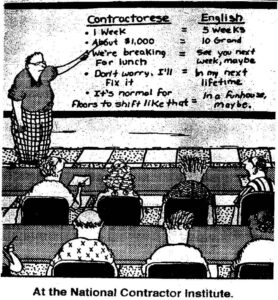
I don’t get it
This is a snapshot of commonly used terms around our job sites when Levco is remodeling in Boise, Idaho. Being familiar with them will help everyone understand or translate construction lingo, with the end goal of better communication overall. The list will grow as we think of more obscure terms. Feel free to comment on terms you would like us to add. All too often, there is a chasm between what we say and what is heard.
Construction Terminology Glossary
A
A/C – An abbreviation for air conditioner or air conditioning.
Abbreviations – These are Levco abbreviations that we use to describe commonly used in-house phrases in the DOW “Description of work.”
- OSCI. Owner Selected, Contractor installed. Owner selects the materials. There is a full Contractor-provided guarantee on materials and installation. This is the most common arrangement for our industry. The Contractor is responsible to pick up and deliver the materials to the site.
- OFCI. Owner-furnished, Contractor-Installed. The owner pays for the item and delivers it to the job site. The Contractor is responsible for proper installation. The contractor provides an installation guarantee; however, there is no contractor-provided material guarantee on these items.
- OFOI. Owner Furnished Owner Installed. These are items that are the owner’s responsibility exclusively.
ADU- An abbreviation for Accessory Dwelling Unit. This is an inhabitable second structure on the same property. It is a classification that has a special set of rules and requirements that must be met before being built. They are often built in conjunction with or above a garage. They are also occasionally referred to as a mother-in-law suite.
AFCI- An Abbreviation for Arc Fault Circuit Interrupter. This is a required type of breaker that helps to prevent fires. It is designed to shut off immediately when two wires arc rather than wait until the wires heat up enough to cause the breaker to flip off. Now required in bedrooms, there is a discussion about adding additional locations.
Aged Home Upgrades—A specialty of Levco, aged home upgrades are a term used to describe older homes that need updating. They are usually very original and have great potential to be updated by opening up kitchens, improving lighting, safety, and functionality, and replacing old water-hog fixtures. In bathrooms, this may mean new flooring, removing wallpaper, and replacing old water-hog fixtures.
Allowance—Levco uses a Material Allowance in rare cases when specific items have not been selected prior to agreement signing. The allowance covers the average estimated purchase price of the items.
Apron– A trim board that is installed beneath a window sill.
Attic vents – Allow the heat in the attic to escape.
B
Balloon Framing is an old-fashioned method of using very long studs in two-story buildings. Outlawed due to fire hazards, it is rarely seen, but it is out there.
Baluster– The posts or spindles that create a railing or balustrade.
Batten- A thin solid board often covers where larger boards meet. It can be horizontal or vertical and is often used in siding applications. Board-and-batten siding. It is also used behind siding in a rainscreen application.
Beam– A horizontal support structure, usually beefy, designed to carry vertical loads and transfer them to walls or columns. In residential remodeling, usually wood. They can be made of engineered lumber (a green option) or dimensional lumber.
Bearing wall – A wall that bears weight. In other words, it supports other structures above and transfers weight down to the foundations. They usually need to stay put. They can be remodeled and replaced with beams and posts. This is a delicate procedure and requires a permit.
Baseboards – The trim is at the bottom of a wall where it meets the floor.
Blocking – Small wood pieces to brace framing members or to provide a nailing base for Sheetrock.
Bonus Room—This is a pop-out to a roof or addition to a garage. It is an area carved out of a gable roof that allows for more ceiling height. We often add them to a truss system because they are essentially free extra rooms.
Brickmould – This is the trim material commonly used on the outside of an exterior door. It is attached to the door jam and makes a nice reveal and covers siding next to the door jam.
BTU– British Thermal Unit it is equal to the amount of energy it takes to raise 1 pound of water (1/10th of a gallon )1 degree. A way to express how much GAS will be needed to run multiple appliances.
Bulkhead – usually an enclosed space, often rectangular in shape, to hide ductwork or anchor cabinets in a kitchen, for instance.
Bull Nose—When used in context, bull nose means rounded corners usually done in metal, which makes for a nice eased edge on drywall corners.
C
Cantilever– The projection of a beam beyond the face of a structure without additional support. When the supporting structure comes from the structure, there must be a 2:1 ratio of interior material to exterior material.
Casing– Wood trim molding installed around a door or window opening.
Caulking- A flexible material used to seal a gap between two surfaces, e.g., between pieces of siding or the corners in tub walls. There are all kinds of materials that come in caulking tubes.
Collar tie– A horizontal member placed between two rafters at a specific vertical distance above the very top plate line for the purpose of limiting outward thrust of the rafters.
Common Wall- This is a wall that is between two inhabited spaces. There are many ways to build one, it involves reducing sound transmission, Resilient channel, double walls , and staggered stud walls are among the methods. In addition, fireproofing is an issue here,
Contractor – A company allowed to perform certain types of construction activities. In Idaho, contractors only need to be registered and have Workman’s Compensation and General Liability insurance at the time of application. Some Specialty contractors require licensing and involve extensive training and annual testing.
There are various types of contractors:
• General contractor – responsible for the execution, supervision and overall coordination of a project and may also perform some of the individual construction tasks. Most general contractors including Levco, hire specialty contractors for such tasks, e.g. electrical, plumbing, HVAC.
• Subcontractor – a specialty contractor who works for another general contractor. All subcontractors have provided a signed agreement expressing understanding of the expectations laid out by the contractor pertaining to best practices and job site behavior. They must also maintain current General Liability Insurance and Workman’s Compensation coverage.
Cove Base– Made of vinyl or rubber this is the material that is commonly used as base board with vinyl or VCT. It is available in wide variety of colors and several heights, 4″ or 6″ . It is easy to install and makes a nice finished look.
Cricket– A ridge or drainage flume structure designed to divert roof framing. Generally found on the high-sloped end of a chimney or the transition from one roof area to another.
Crown molding—A molding used on a cornice or wherever an interior angle is to be covered, especially at the roof and wall corners.
D
Design Build – An entity responsible for designing and building the remodeling space. This is what Levco Builders LLC does.
DIY- also spelled DI-Why An abbreviation for Do It Yourself. Often used in TV shows that make remodeling look ridiculously easy and fast for homeowners to do themselves.
Dormer – A pop-out of a gable roof used to add headroom and affordable additional living space.
DOW- Description of work. This is the approved document that describes all of the elements and specifications of the project.
Drywall – A panel made of gypsum plaster and encased in a thin cardboard. Usually 1/2″ thick and 4′ x 8′ or 4′ x 12′ in size. The panels are nailed or screwed onto the framing and the joints are taped and covered with a ‘joint compound’. ‘Green board’ type drywall has a greater resistance to moisture than regular (white) plasterboard and is used in bathrooms and other “wet areas”. Drywall came from the marketing side instead of Lath & Plaster, considered a “wet wall.” Drywall sped up construction dramatically. It is also used interchangeably with Sheetrock, which is a name brand.
Duplex– used in real estate means two units, in Electrical talk it is a 2 plug in one receptacle. (Fourplex has the same real estate and electrical meanings)
Ducts– The heating system. Usually round or rectangular metal pipes installed for distributing warm (or cold) air from the furnace to rooms in the home.
E
Easement– A formal contract that allows a party to use another party’s property for a specific purpose. e.g. A sewer easement might allow one party to run a sewer line through a neighbor’s property.
Elevation – Shown in a set of architectural drawings, it is the view from the front and sides of the home or building.
Escutcheon– A cover plate that goes around a faucet or door lock to make a clean finishing look.
F
Fascia – Horizontal boards attached to rafter/truss ends at the eaves and along gables. Roof drain gutters are attached to the fascia.
Fire Taping– This means adding the first coat of mud and tape to drywall. This essentially ties the drywall together and covers the screws to make a uniform look, typically seen in finished garages. It is the first step in any taping and texturing project.
Flat work– Common word for concrete floors, driveways, basements, and sidewalks.
Floor plan – Shown is a set of Architectural drawings, it shows the layout of the home or building (bedrooms, bathrooms, living rooms, kitchen, etc)
Flue – Large pipe through which fumes escape from a gas water heater, furnace, or fireplace. Normally, these flue pipes are double-walled, galvanized sheet metal pipes and are sometimes referred to as a “B Vent”. Fireplace flue pipes are normally triple-walled. In addition, nothing combustible shall be within one inch of the flue pipe.
Footing – The base of a foundation it is the piece that the Stem wall is connected to. It is designed to spread out the weight of the structure over a larger footprint and prevent settling and movement.
Foundation – The supporting portion of a structure below the first floor construction or below grade, including the footings and stem walls.
Framing – Lumber used for the structural members of a building, such as studs, joists, and rafters.
G
Gable– A home’s end, upper, triangular area beneath the roof.
Gable Vent– A vent placed high on the gable end that will allow heat to escape
Gauged– A reference to stone, specifically stone to be used as tile. Gauged material has been honed on one side, creating a surface with consistent texture and thickness. Because the manufacturing process requires more effort, gauged tile almost always comes with a higher price tag
GFCI, or GFI– An abbreviation for Ground Fault Circuit Interrupter- is an ultra-sensitive plug designed to shut off all electric current. Used in bathrooms, kitchens, exterior waterproof outlets, garage outlets, and “wet areas”. Has a small reset button on the plug with a test button too. They are the most common reason for “things not working”
Girder – A beam of wood or steel used as the principal support of concentrated loads at points along its span.
Grade – Ground level or the elevation at any given point. Also, the work of leveling dirt. Also, the designated quality of a manufactured piece of wood.
Grade beam– This is a type of foundation that is poured on top of concrete piers, not commonly used in this area. We typically use footings and stem walls.
H
Hardware – All of the “metal” fittings that go into the home when it is near completion. For example, door knobs, towel bars, handrail brackets, closet rods, house numbers, door closers, etc. The Interior Trim Carpenter installs the “hardware.”
Header – (a) A beam placed perpendicular to joists and to which joists are nailed in framing for a chimney, stairway, or other opening. The horizontal structural member over an opening is often hidden, for example, over a door or window.
HEPA- An abbreviation for High Efficiency Particle Air. Referring to an efficiency rating that prevents 99.97% of particles over .03 microns from passing through it. Often associated with vacuums, HEPA vacuums are required when performing LSWP
Hip– A type of roof that refers to a sloped side see article here
HVAC: An abbreviation for Heat, Ventilation, and Air Conditioning.
Heat Pump: An efficient way of heating and cooling using the properties of compressing gasses that can switch the fluid direction to either heat or cool. This is what is typically used in Ductless Mini-Splits
I
Insulation – Any material high in resistance to heat transmission that, when placed in the walls, ceiling, or floors of a structure, will reduce the rate of heat flow.
J
Joists – One of a series of parallel framing members used to support ceiling loads and supported in turn by larger beams, girders or bearing walls.
K
King Stud– The first, full height stud on either side of a door or window opening.
L
Lavatory—An old term for a sink. (It is occasionally used to mean the entire bathroom.) Also abbreviated as a Lav, this is Plumbers’ speak.
Load bearing wall – A wall that supports any vertical load and its own weight.
LSWP- An abbreviation for Lead Safe Work Practices. It refers to a scripted set of safety precautions and practices dictated by the EPA Environmental Protection Agency.
LVL—laminated Veneer lumber. Marketed under the trade name Microllam®, LVL can be made with wood from smaller, faster-growing trees. Microllam products are typically available in various thicknesses and widths that can be wider in dimension than native-grown lumber. We would like to use them as a green alternative.
M
Muntin- A divider in multiple pane windows, commonly wooden in older homes. Often faux dividers to save money
N
Newel post: This is the post at the end of the stairway railing or balustrade. It can be at the top or the bottom and is usually dominant in size and decorative.
O
On Center (O.C.) – The spacing measurement for studs, rafters, and joists in a building from the center of one member to the center of the next.
ORB– short for the color Oil Rubbed Bronze. A dark brown, often seen on metal hardware and plumbing accessories.
OSB: Oriented Strand Board. This is an engineered material that is made of scrap wood. It works like plywood and is commonly used in its stead. It has a smooth side and a rough side. It is a green building material.
Overhang: The outward-projecting eave or soffit area of a roof, the part of the roof that hangs out or over the outside wall.
P
Parging– filling holes on concrete. This is done on the outside with tar waterproofing or cementitious material to achieve a look. On the inside it is a cosmetic layer to fill holes.
Plywood– A panel (normally 4′ X 8′) of wood made of three or more layers of veneer, compressed and joined with glue, and usually laid with the grain of adjoining plies at right angles to give the sheet strength.
Plinth Blocks– A square placed at the base of a column, or more commonly used as a square decorative block at the intersection of two pieces of door casing.
Plumb-A version of a level, but on the vertical plane
Post Tensioning:– an engineering method of pre-stressing beams with wires to support far more weight and span further. Primarily used in concrete construction in commercial applications, it has applications in residential remodeling as well.
Pressure Treated- This is specially treated lumber that, through a process of vacuuming and pressure treatment, impregnates the lumber with various preservatives and insect repellents. This treated lumber is used when there is concrete-to-wood contact or wood-to-dirt contact. It comes in green and brown. It is chemically treated and is now mandated to be safe for playground use as it no longer has arsenic. It should NEVER be burned as firewood. Here is everything you ever wanted to know about pressure-treated lumber
PV – Photovoltaic, the name for changing natural sunlight into electricity.
Q
R
Rainscreen– A type of siding technique. It describes brick veneer, EFIS stucco systems, and other types of siding that leave an air gap behind the siding when applied over a vapor barrier. The siding is held away from the vapor barrier by battens, allowing ventilation. It is a green technique because it allows the vapor barriers to breathe, thus improving the indoor air quality.
Receptacle– Referring to an Electrical Outlet
Rafter– Lumber used to support the roof Sheeting and roof loads. Generally, 2 X 10’s and 2 X 12’s are used. The rafters of a flat roof are sometimes called roof joists.
RCE or RCT Abbreviations for the contractor registration number given by the IBOL (Idaho Bureau of Occupational Licensing). Contractors are registered, not licensed, in Idaho. The number must be seen along with the logo in all instances, on stationary cards, etc. Research on the currency of that registration can be found on the IBOL site.
Register– The grill that air comes through in a forced air HVAC system
Return– The duct system that brings air back to the furnace.
Repurposing– The art of reusing a material or fixture for something else. This is a green thing to do and is a goal for limiting landfill usage.
Ridge vents: Installed on the roof, allowing heat to escape from the attic.
Riser– the vertical part of a stair. between a maximum 7 3/4″, they must be within 3/8″ of each other
Roof decking – Plywood or OSB that goes on the rafters and under the roof, also called sheeting.
S
Section: Also known as a cross-section, this is a view of an architectural drawing that cuts through a view and shows what is inside a wall, for instance.
Sheetrock – A panel made of gypsum plaster and encased in a thin cardboard. Usually 1/2″ thick and 4′ x 8′ or 4′ x 12′ in size. The joint compound. There are different colors, Green board type drywall has a greater resistance to moisture than regular white board and is occasionally used in bathrooms. It is also a brand name for Drywall.
Sheeting / Sheathing– used interchangeably, it is the outer layer of the framing also on the roof
Shingles: Roof coverings made of asphalt or other materials designed to be long-lasting, good-looking, and waterproof. Color affects heat transfer.They are also used as siding.
Stringer: A stringer is a piece of lumber cut to place step treads and risers on. It is challenging to cut correctly and is usually taken for granted. They are seen used by themselves or in multiples for strength.
Shitter- Port-a-potty, AKA a Stool, Thunder hut, Throne, Toilet, Crapper after Thomas Crapper of England (who promoted the sanitary virtues of the device in the late 1800s), Water Closet (WC seen on plans) is the plumber’s lingo.
Sister– “Sistering” is a method of adding a similar piece of lumber to say a bent board and strengthening or splinting with nails and glue
Soffit – The area below the eaves and overhangs. The underside where the roof overhangs the walls. Usually, the underside of an overhanging cornice.
Soffit Vent—This is a vent placed in the soffit. It allows fresh air in and hot air to escape from the ridge or gable vents.
Stem Wall: This is the vertical piece of concrete that connects the footing to the framing. It is designed to stick over the dirt at least 6″.
Stud – A vertical wood framing member, also called a wall stud, attached to the horizontal sole plate below and the top plate above. Normally 2″ X 4″ or 2″ X 6″ (not actual size). Other less-known studs include
- King Stud : the first, full height stud on either side of a door or window opening.
- Jack Stud : the short studs that support the header over a doorway or window opening. It’s also called a trimmer stud and it is attached to the king stud.
- Cripple Stud : the short stud under a window or above a door opening.
Square– Referring to a 90-degree angle
Subfloor: This is the material that goes on top of the floor joists. We have found all sorts of materials used, from diagonal 3/4″slats to 7/8″ OSB. It is always under the underlayment. Hardwood floors can be put directly on it.
Supply– the duct system that brings air into a room
Swale- A depression in the earth used as a natural-looking area to gradually drain excess water through percolation back into the soil
T
T & G: short for Tongue and Groove, a method of joining wood together where a spline fits into a groove of the other board. seen in flooring and other decorative applications
Transition: This is used to explain the connection between different surfaces. Often, a piece of dissimilar material is used to cover the joint. Unusual transitions are made to disguise a change in flooring altitude, mainly when an additional layer of flooring is applied.
Trim: The finish materials in a building, such as moldings applied around openings (window trim, door trim) or at the floor and ceiling of rooms (baseboard, cornice, and other moldings). Also, the physical work of installing interior doors and interior woodwork, including all handrails, guardrails, stairway balustrades, mantles, light boxes, bases, door casings, cabinets, shelves, window sills, aprons, etc.
Trusses: These are pre-manufactured structural pieces set on top of the top plate, occasionally by crane. They support the roof and hold the walls together. They are used to speed the construction process and add strength. The other option is to “Hand Stack the roof.”
U
Underlayment—This is the material placed below flooring. It is often particle board and comes in various thicknesses. It is placed on top of the subfloor.
V
VCT– Vinyl Composition Tile. Often used in commercial applications on cement floors. they are commonly 1′ square and set in interesting patterns. There are a multitude of colors. It is easy to install but requires a smooth flat surface or they will telegraph imperfections.
Visqueen – The brand name of a polyethylene plastic sheet manufactured by a British company. The term is used generically to describe plastic sheeting of all kinds. It comes in clear, opaque, and black and is used for all sorts of things.
X
Y
Yard: This is a unit of measure that is 3′ x 3′ and is commonly used to describe carpeting. In a cubic yard sense, it is 3′ x 3′ x 3′, typically used to describe the measure of concrete.

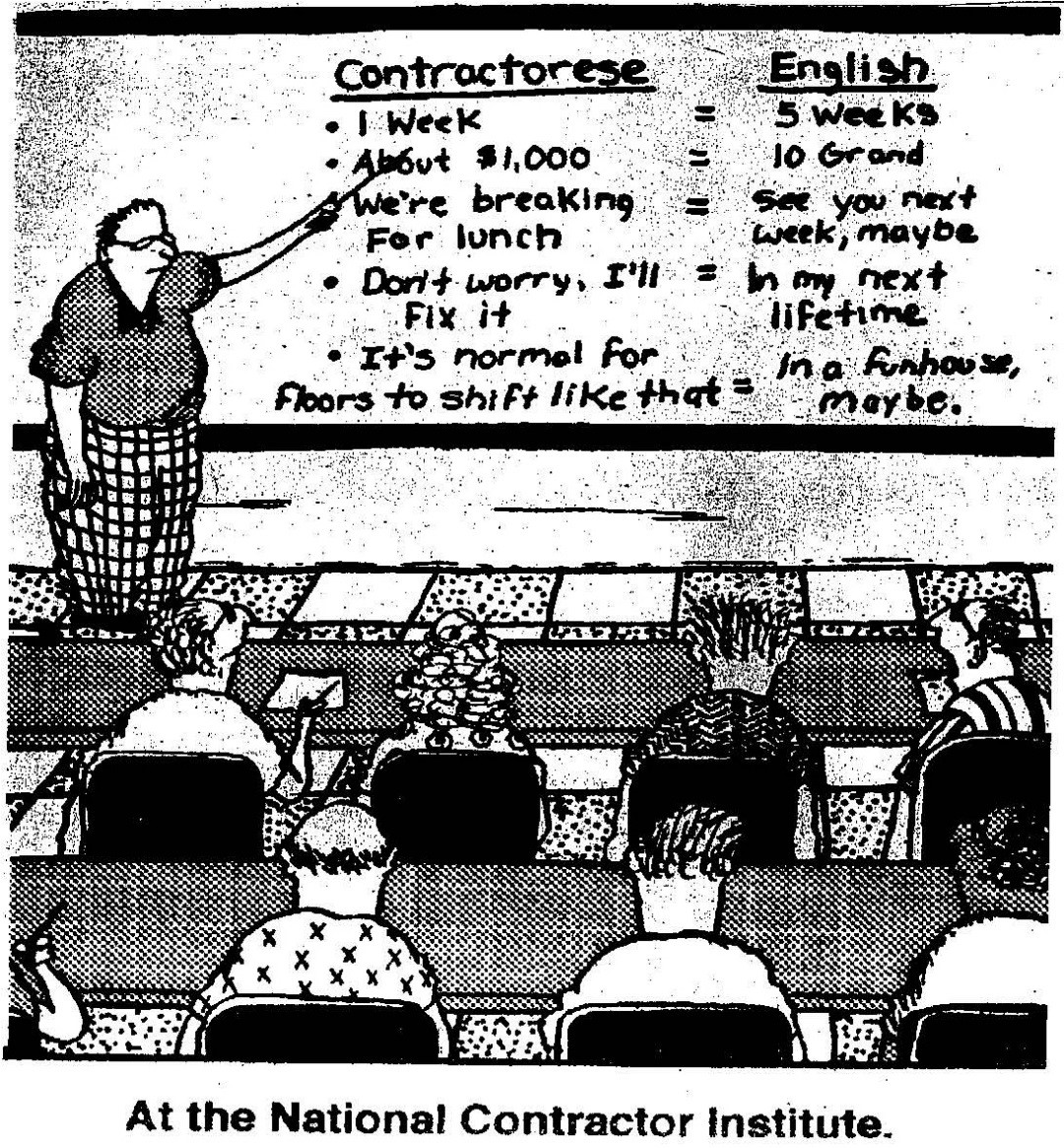


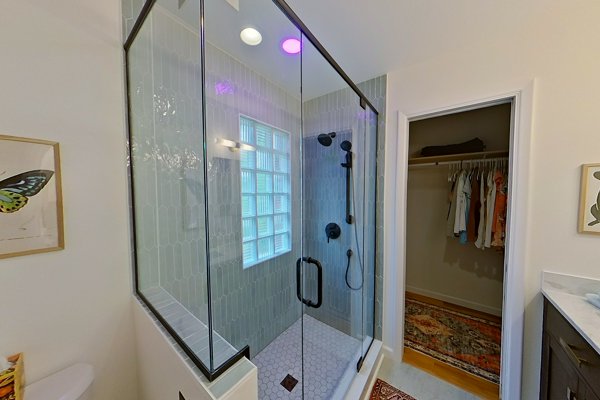
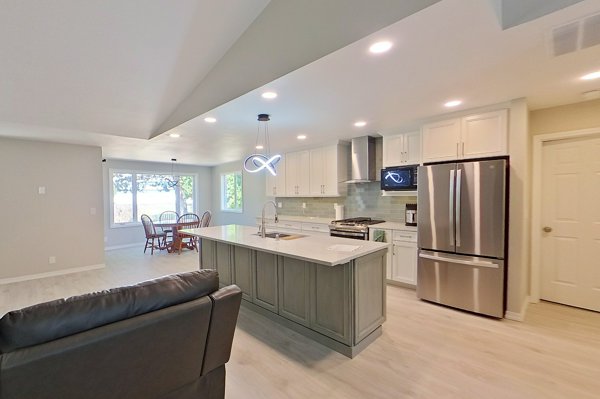

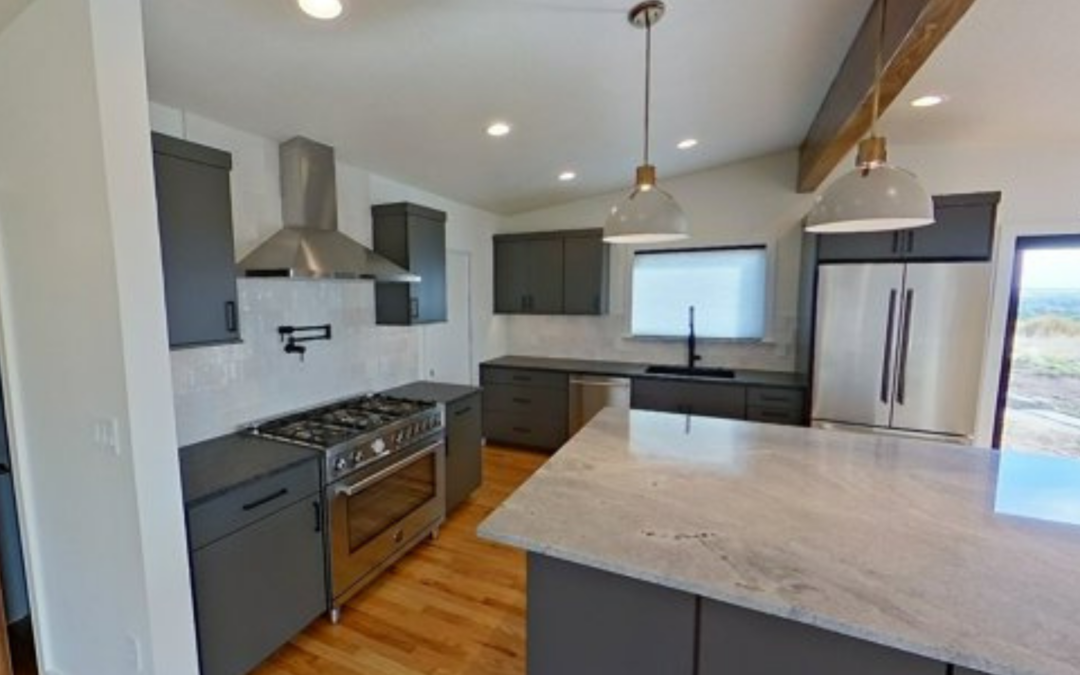
Joe – You have to add OSCI, OFCI, OFOI and URGH (when a client becomes inarticulate from too many choices) and of course WAH – which means Joe fix this!
Lisa I have updated the site to include these terms, Thanks